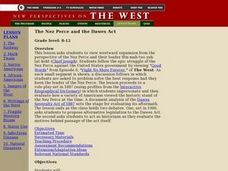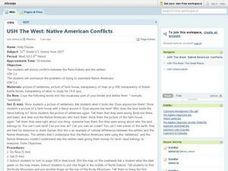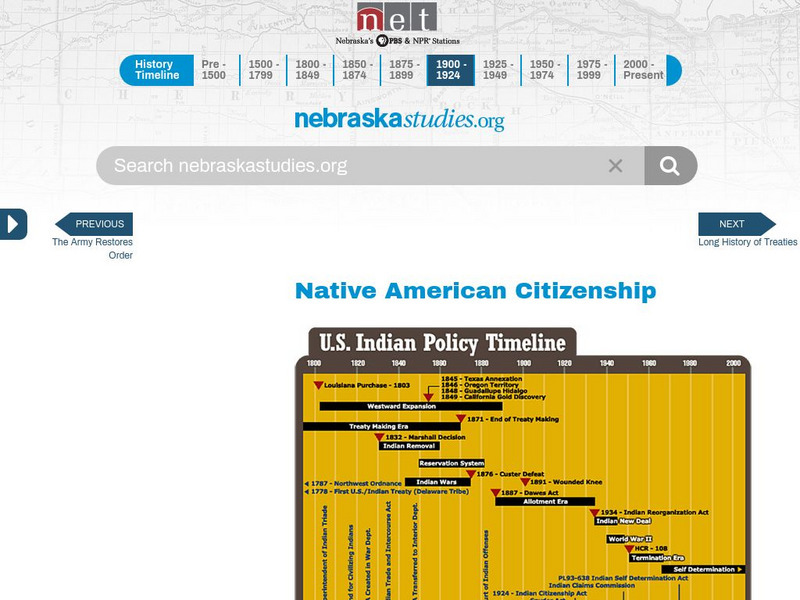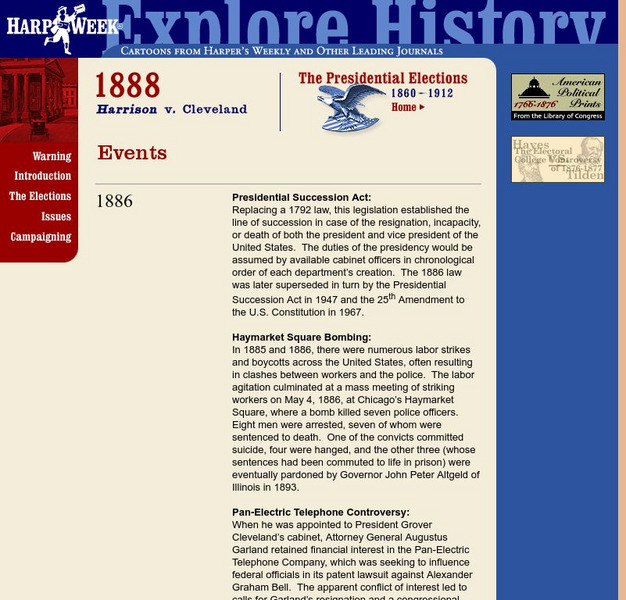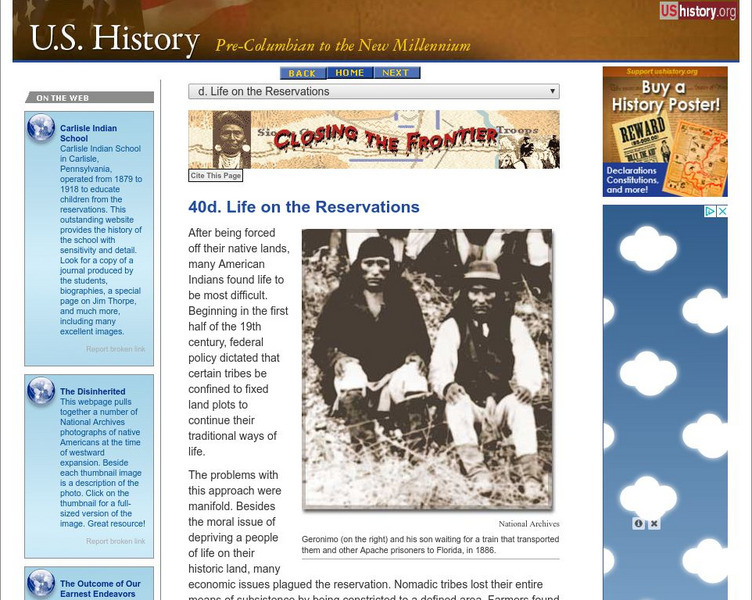Curated OER
Analyzing Primary and Secondary Sources to Assess the Decisions and Policies of Sitting Bull, Red Cloud, and the U.S. Government
Students examine U.S. policies regarding Native Americans. In this Native American history lesson, students analyze provided primary and secondary sources concerning Red Cloud, Sitting Bull, and the Dawes Act. Students use the provided...
Curated OER
The Nez Perce and the Dawes Act
Eleventh graders explore westward expansion in the United States. For this US History lesson, 11th graders watch the epic struggle of the Nez Perce. Students evaluate how a variety of Americans viewed Nez Perce through a role play.
Curated OER
U.S. History: Native American Conflicts
Eleventh graders discuss the wars with the Plains Indians and the subsequent cultural difficulties of assimilation. Part of the lesson examines the clash of cultures and beliefs about land ownership. Prior to taking a quiz, 11th...
Curated OER
Forced to Move in More Ways Than One
Eleventh graders explore the Native American movement. They study the Indian Removal Act of 1830, the Dawes Act of 1887, and the Indian Boarding Schools in 1887. They research each episode and create a Venn diagram poster.
Curated OER
Debating for Land
Students research pertinent information based on historical facts and is supported by quotations from primary sources in order to prepare for a class debate about land ownership in the 19th century.
US National Archives
Our Documents: Dawes Act (1887)
Read about the development, purpose, and effect of the Dawes Act, which was also known as the General Allotment Act. This site has images of the original document.
US National Archives
Our Documents: A National Initiative on American History, Civics, and Service
Our Documents is home to one hundred milestone documents that influenced that course of American history and American democracy. Includes full-page scans of each document, transcriptions, background information on their significance, and...
PBS
Pbs: New Perspectives on the West
This in-depth resource presents a history of the American West from pre-Columbian times until World War I with profiles, documents, and images. It encourages visitors to link these into patterns of historical meaning for themselves....
PBS
Pbs the West: The Nez Perce and the Dawes Act
This companion article from the PBS series, "New Perspectives on the West," offers a lesson plan which approaches the Dawes Act from the perspective of the Nez Perce.
Nebraska Studies
Nebraska Studies: Native American Citizenship
After invading the land long lived on by the Native Americans, the United States government only gave them the right to citizenship in 1924 as detailed here.
Nebraska Studies
Nebraska Studies: The Dawes Act
The Dawes Act, also known as the General Allotment Act, was written by Henry Dawes in an attempt to assimilate Native Americans into American culture. Use this site to learn about what propelled Dawes to write this document and how his...
Library of Congress
Loc: Today in History: June 2: Indian Citizenship Act
On June 2, 1924, Native Americans were granted American citizenship via Indian Citizenship Act. Learn about this act of congress and how it impacted American Indian culture.
Digital History
Digital History: Native Americans
Find out about how Native Americans fared during the passage of so much legislation during the New Deal. See which progams helped them, and read about the changes made in decades-old laws.
US National Archives
Nara: Teaching With Documents: Indian Territory, 1885
An 1885 map showing the holdings of the many Indian tribes displaced to the Indian Territory. From the National Archives.
PBS
Pbs Archives of the West: Dawes Act
The text of the famous Dawes Act of 1887 which attempted to provide allotment of lands to Native Americans.
Other
Native American Documents Project
This scholarly project from California State University analyzes the effect of the Dawes Act, or General Allotment Act, which divided Indian lands into individual holdings to promote assimilation by deliberately destroying tribal...
US National Archives
Docsteach: Assimilation of American Indians
In this activity, students will analyze primary sources to determine the role and activities the federal government undertook in an attempt to 'Americanize' or assimilate Native Americans.
University of Virginia
Miller Center at Uva: u.s. Presidents: Grover Cleveland: Domestic Affairs
Read a good account of the domestic policies of Grover Cleveland's first administration. His ineffective leadership and attitudes towards race, women's rights, and immigration is somewhat surprising.
Countries and Their Cultures
Countries and Their Cultures: Multicultural America: Ojibwa
Provides an overview of the traditional culture and lifestyle of Ojibwa. (Note: Content is not the most current.)
Khan Academy
Khan Academy: Ap Us History: Period 6: 1865 1898
This Khan Academy resource provides a table of contents with notes for several sections of AP US History: Period 6: 1865-1898.
Harp Week
Harp Week: The Presidential Elections: Events
Read about the domestic policies and events that occured in Grover Cleveland's first term of office. Many of these were events on which he would run as he sought his second term.
Country Studies US
Country Studies: The Plight of the Indians
This site explains how as westward expansion grew, more and more Indians encountered settlers, ranchers and miners who sought life, land, and riches out West. Conflicts between settlers and Indians soon involved the federal government...
PBS
Pbs: Archives of the West: Selections From "With the Nez Perces"
Contains selections from "With the Nez Perces: Alice Fletcher in the Field, 1889-92" by E. Jane Gay, which provided an anthropological look at the Nez Perce Indians and their bewilderment at the Dawes Act.
Independence Hall Association
U.s. History: Life on the Reservations
Read about the probems caused by restricting Native Americans to reservations after their collective defeat by the end of the 19th century. See how the Dawes Act tried to address these problems, but only made things worse.



